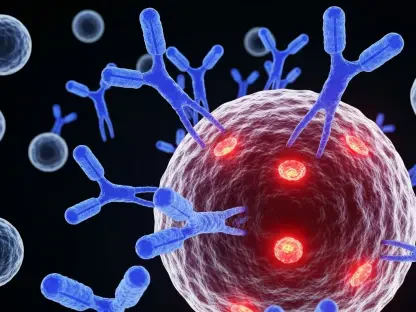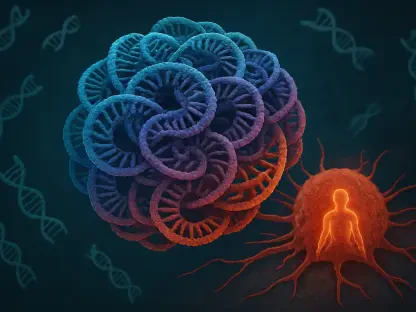The scourge of chronic abdominal pain, a condition affecting millions worldwide, has driven scientists to search for novel treatment options, as conventional therapies often exacerbate symptoms or pose risks of addiction. Emerging research reveals a groundbreaking development in the form of an oral drug derived from oxytocin, designed to alleviate such pain. Conditions like irritable bowel syndrome and Crohn’s disease often manifest chronic abdominal discomfort, yet traditional painkillers can worsen these symptoms or introduce addiction hazards. As researchers grapple with these challenges, a promising new direction has been discovered in gut-specific medication development. Led by Markus Muttenthaler, researchers have redirected their focus to targeting specific receptors in the gut, uncovering oxytocin receptors in colonic neurons, which might hold the key to effective pain management without the side effects typically associated with existing treatments.
The Journey to a Novel Pain Solution
Chronic abdominal pain management has long puzzled the medical community, often resulting in reliance on treatments such as nonsteroidal anti-inflammatory drugs and opioids. These treatments, although effective for other types of pain, can compound discomfort for sufferers of gastrointestinal conditions. Muttenthaler’s team identified a critical insight: oxytocin receptors, when activated, might provide a more precise means of alleviating pain transmitted from the gut to the brain. Initial studies using mice illuminated a notable increase in oxytocin receptor numbers within colonic neurons in subjects with chronic abdominal pain. This revelation paved the way for exploring oxytocin as a potential analgesic, an avenue previously underestimated in the realm of pain management.
However, utilizing oxytocin presented formidable challenges. Its chemical structure is susceptible to rapid degradation, disintegrating in the digestive system within mere minutes, thus rendering it ineffective as an oral medication. The primary endeavor became how to stabilize this peptide to ensure its longevity and effectiveness within the body. Muttenthaler’s group innovatively modified oxytocin, enhancing its structure with more robust chemical groupings. This effort yielded approximately 60 variations, a handful of which demonstrated substantial resistance to enzymatic degradation while still maintaining active receptor engagement capabilities essential for pain relief. These developments signify a potential paradigm shift in pain treatment beyond traditional methods that non-specifically target pain pathways.
Promising Results and Future Prospects
Testing in mice presented promising outcomes, with one particular oxytocin variant displaying remarkable efficacy in reducing pain responses under increased abdominal pressure. Despite these promising results, obstacles remain before a market-ready product can be viable. Published studies highlighted achievements, but they also brought attention to possible side effects, including unanticipated toxicities and adverse immune reactions. As a result, comprehensive testing and refinement are necessary to ensure that the drug targets oxytocin receptors without triggering harmful reactions elsewhere in the body. An international patent secured for this innovative drug candidate marks a significant step forward in recognizing its potential, yet there remains considerable work to navigate these potential pitfalls.
While not yet available commercially, the innovative approach to harnessing oxytocin’s therapeutic qualities has fueled optimism within the field for new pain management solutions. This method’s emphasis on targeting gut-specific receptors underscores the evolving landscape of gut-focused peptide therapies. Unlike traditional analgesics that bluntly suppress pain, this new class of treatments presents a more refined strategy. By concentrating on receptor-specific interaction, researchers are hopeful that these developments can generate effective, targeted relief for sufferers of chronic abdominal pain—ushering in a new era of pain management that effectively alleviates suffering without adverse consequences.
Implications for Future Treatment Strategies
The challenge of managing chronic abdominal pain has long confounded the medical community, leading to heavy reliance on nonsteroidal anti-inflammatory drugs and opioids. While generally effective, these can worsen conditions for those with gastrointestinal issues. Muttenthaler’s team uncovered a significant insight into this dilemmthe activation of oxytocin receptors might offer a more precise approach to alleviating pain signals from the gut to the brain. Their initial research with mice showed a notable uptick in oxytocin receptor numbers in colonic neurons of chronic pain sufferers. This discovery suggested that oxytocin could be a promising analgesic, a possibility previously overlooked in pain management approaches.
Yet, using oxytocin posed major hurdles, primarily due to its chemical susceptibility to rapid breakdown in the digestive tract, making oral administration ineffective. Muttenthaler’s team set out to fortify oxytocin’s structure, creating about 60 variants with enhanced robustness against enzyme degradation while ensuring receptor engagement for pain relief. These advancements hint at a paradigm shift in pain treatment, moving beyond traditional, non-specific methods.









